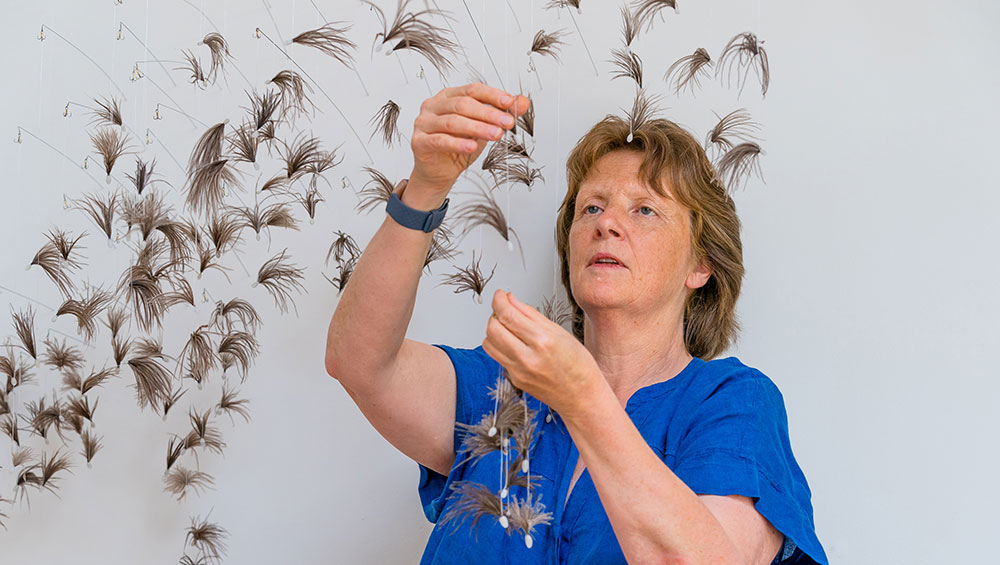
by ANNA McNAY
Former classical musician Susie MacMurray (b1959) retrained as an artist during the era of the YBAs, but she is as far removed from their style of “one-liner” work as could be, focusing very much on the materiality and poetry of a piece, combining unconventional materials – such as red velvet, feathers, wax and barbed wire – to create seductive yet misleading installations, which lure the viewers in, but then cause them to step away in surprise and ask questions. Vulnerability and resilience, danger and attraction, mystery and wonder, life and death – these are all present in MacMurray’s work, which, like a fairytale, centres on alchemy and transformation.

Susie MacMurray. Clutch, 2019. Silk velvet, wax and fish hooks, 12 x 16 x 16 cm. Photo: Ben Blackall and Steve Russell Studios.
With an exhibition at Pangolin London, including a site-specific installation – or “drawing in space” – and some new bronze works (MacMurray’s first time working with this material), made in the Pangolin foundry, the artist spoke to Studio International about her collaborative and repetitive way of working, her love of dualities, and her self-discovery as an artist later in life.
Anna McNay: Before we entered the second lockdown, you had enjoyed about a fortnight of your solo exhibition at Pangolin London, due to run until 22 December [extended until 31 January 2021]. Hopefully, there will still be time for people to visit once restrictions are lifted, because, I have watched the online walk around you did with the gallery director, Polly Bielecka, and it really does look an impressive show.
Susie MacMurray: Hopefully, yes. But there is quite a virtual presence, too. The gallery has done really well. We did a livestream opening, which was fun, then the walk around, and the catalogue is online, too. Maybe people can still see something if they walk past the gallery, as well, assuming the shutters are not down.
It was like a brief moment of freedom, which is very apropos the show. It felt like a tiny window, in which we could all get out, and it was exhilarating putting the show on. I was able to go down from Manchester to install it, having been holed up for so long. It felt liberating to be able to go into a gallery, make art and put the installation together from scratch. We were lucky with the timing. If it had been a fortnight later, it would have been too late.
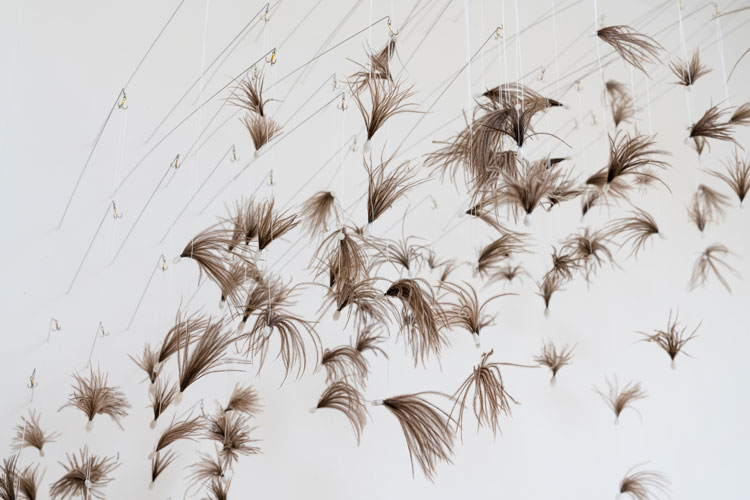
Susie MacMurray. Murmur, 2020. Ostrich feather barbs, piano wire, fish hooks, wax and upholstery thread, dimensions site specific. Photo: Ben Blackall and Steve Russell Studios.
AMc: The installation you are talking about is, presumably, Murmur, which is a site-specific piece, which has also lent its title to the exhibition as a whole.
SM: Yes. It was in my mind before the first lockdown happened, but the exhibition got postponed, and the piece evolved as a result. My work is about the lines between vulnerability and resilience, danger and attraction, and all of those juxtapositions, but it became very relevant at that time, with the sense that, suddenly, everybody was dealing with those feelings much more overtly, not just me. I use my art to deal with those feelings and conundrums.
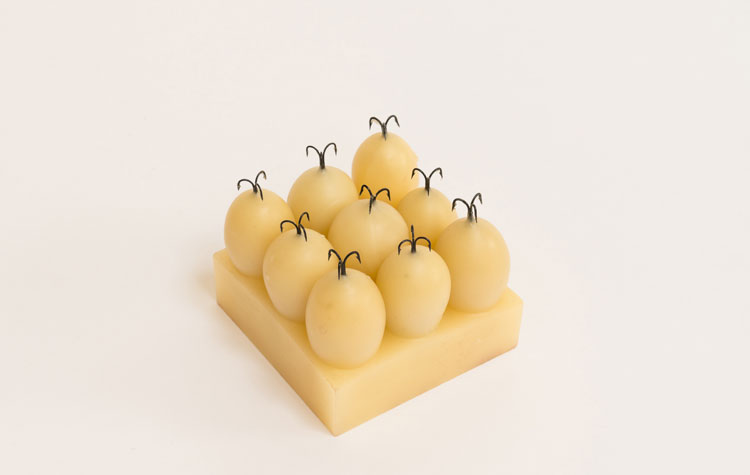
Susie MacMurray. Brood, 2020. Wax and fish hooks, 7 x 9 x 9 cm. Photo: Ben Blackall and Steve Russell Studios.
AMc: Can you talk a bit about the materials you used for the installation, because, here, as well as more generally in your practice, they are not the most conventional sculptural materials. We are talking ostrich feathers dipped in wax, hung with little fishhooks and piano wire …
SM: Yes, I’m not exactly your classic sculptor working in bronze or stone, but then that’s only one part of the sculpture world, isn’t it? Materials all carry their own connotations, and I like playing with them. I think that’s also why I enjoy doing site-specific work, because the venues suggest new materials and new ideas that I can then play with, orchestrate and juggle. A feather is never just a feather, and a fishhook is never just a fishhook. I am very attracted to the physicality of stuff, but also its sensuality, and that reflects the dilemma I have between making something very physical and solid and yet also very vulnerable.
I used to be a classical musician, and it equates, in a way, to that, because you are dealing with the ephemeral and the physical at the same time in that world as well. What you do disappears the moment you’ve done it, it’s only happening while you’re doing it, and you have to learn to deal with that loss and hold on to the memory – the body memory, the emotional memory – of that thing. Maybe that’s why I’m attracted to this way of working, I don’t know. I think there is one site-specific work I made, in a hospital, which has been there for the best part of 10 years, but, on the whole, the things I’m commissioned to do in art spaces and galleries are temporary, and that’s part of their nature. I couldn’t use the kinds of materials I use if I was required to make things permanent. But I think that’s part of what makes them precious as well. Combining things like fishhooks, feathers and wax throws up so many dualities. You look at a fishhook, and you can either be the catcher or the caught. I find things like that quite interesting, and it says something about the viewer, depending on what they assume, and, in that way, it pulls them into the debate.
AMc: From a distance, the works with red velvet in particular are very appealing. They make you think they are beautiful, but then, as you get closer, there are often also sharp objects incorporated, such as barbed wire, and the whole effect becomes less comfortable and more unsettling.
SM: Yes, and then you have to stop and think. One of the pieces that had a big effect on me when I was in art school was The Light at the End (1989) by Mona Hatoum. I never saw it in the flesh, only pictures in books, but it is like one of those old three-bar electric fires that glow orange, and I didn’t even need to physically see it to find it incredibly powerful – the fact that it was glowing in the corner of a white cube gallery, attracting you, and yet completely lethal. That had quite an effect on my practice, because it made me understand something about what art can do, and how it can absolutely physically pull you into itself. I’m interested in artworks that reveal themselves – as you say, it’s quite seductive, reeling people in, and making them think and ask questions.
AMc: You work with very specific materials, too. For example, the barbed wire you used for Cloud (2015).
SM: Yes, Cloud was an installation commissioned for the Great Hall in Winchester as part of the first world war commemorations. I used military barbed wire, which had been on the Ministry of Defence training grounds at Aldershot since the Falklands conflict. It had seen soldiers training to go to the Falklands, and then to Kosovo, and then to Afghanistan and Iraq. It really attracted me because it had a provenance of conflict, which made a lot of sense in the context of what I was looking at. I didn’t want my work to be about memorial. I wanted it to be different. I didn’t want to go down the poppies route, because I think that’s quite problematic.
The soldiers in the training regiment helped me make the piece, and we talked a lot about post-traumatic stress disorder and the cloud of war. That barbed wire became very special. When the piece came down, they got rid of a lot of it, but I kept quite a bit, because I realised it was something I wouldn’t ever be able to get hold of again. It made me think more, and I pushed it further, and it has crept into other installations and artworks, because it has that sort of shorthand in it – be it gathering, be it people.
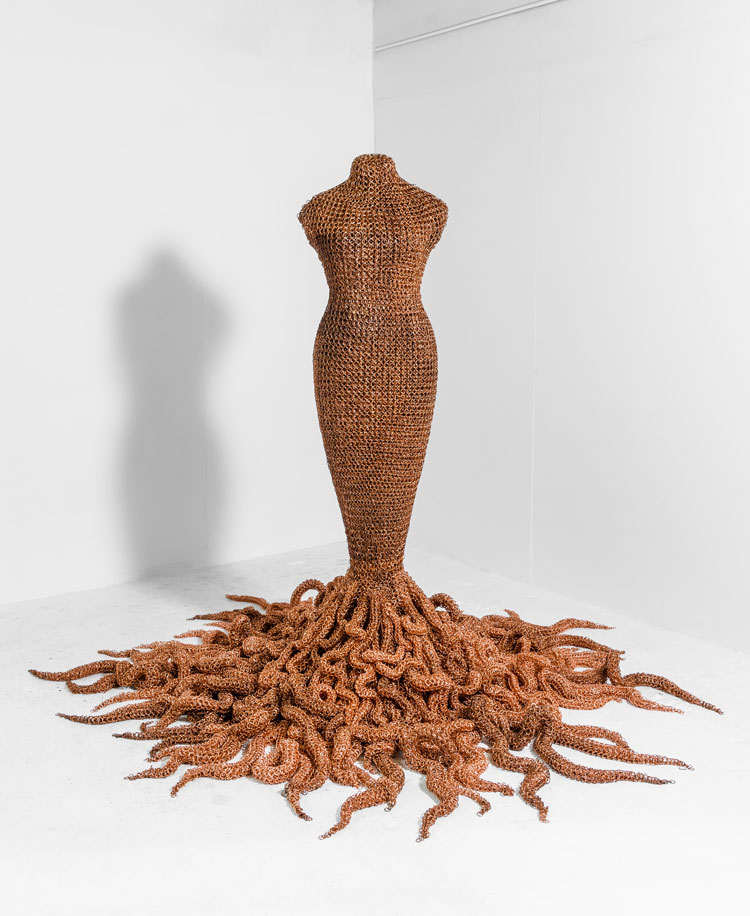
Susie MacMurray. Medusa, 2014-15. Handmade copper chain mail over fibreglass and steel armature, 182.9 x 243.8 x 243.8 cm (72 1/8 x 96 x 96 in). Photo: Ben Blackall and Steve Russell Studios.
AMc: You mention collaborating with the soldiers, and I know collaboration is quite a common feature of your practice. For example, for your sculpture Medusa, you worked with a group of female art students.
SM: I quite often end up working with art students. Because of the way I work, I need help. Collaborating is the only way to do some of the things I do, because they are so labour intensive. I love it, and it is what I do, and it’s my way of working, and it always has been, even when I was a musician, and I used to have to make the reeds for my instruments. Whether I knew I was a sculptor or not, I was always making things, right back from when I was 10. But, to do something on a large scale, you can’t do it without help, and, as an artist, you can’t afford to pay people all the time. So I collaborate with volunteers. For Medusa, we sat round like a group of women doing a quilt, or stitching, or weaving. It is quite an ancient sort of thing to do, isn’t it, really? That scene of just sitting round and doing and doing and doing. In one way, what else is there? The world is built on repetition.
AMc: You have mentioned repetition before, as well, in regard to your history as a musician, and the repetition of scales and practice. It seems that quite a lot has carried over from your career in music to your sculptural one.
SM: Yes, I think it has. I didn’t realise it at first. It was only when I went to do my MA that I began to interrogate why I had become this particular kind of artist. When I went to do my foundation course, I thought I might do something like graphic design or illustration, but I’m quite undisciplined. I am undisciplined in one way and very disciplined in another. There’s something about repeating things. I guess it’s the humanity of the attempt to repeat things, and yet being doomed to fail. Things evolve through repetition. It’s the stuff of creation. It’s how the world is made, from a molecular level upwards. Everything is put together and repeated and layered on top of one other.
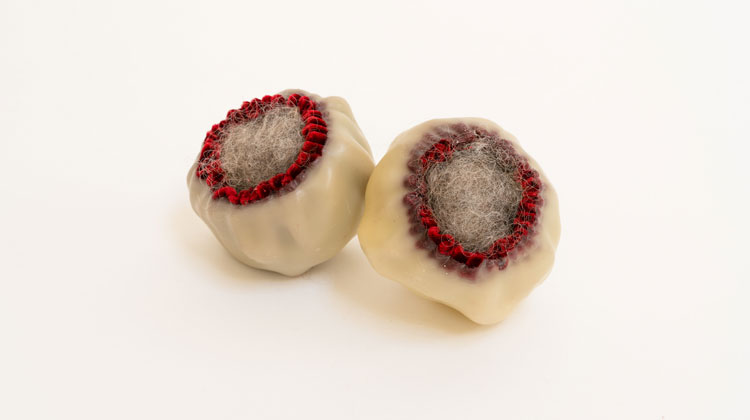
Susie MacMurray. Sisters, 2020. Wax, silk velvet, sheep’s wool and perspex box, 26 x 25 x 25 cm. Photo: Ben Blackall and Steve Russell Studios.
I want to be immersed in things – emotionally and physically – because that’s what I’m used to, and it’s a great joy. It’s the one thing I really miss from the music – being in the middle when it’s all happening, with everybody around you, and you’re making this thing that’s just so much more than you could do by yourself, and it is absolutely transformational. It’s euphoric, almost, and maybe I’m trying to crawl back into that through my installations. Maybe that’s why I make them. I don’t know, it isn’t conscious.
AMc: What made you change career?
SM: I had some therapy, to be honest. I was having counselling: life had gone a bit pear-shaped, and I was questioning who I was and what the point was, and all that stuff. And the therapist asked if I had ever done any painting. I had done a little bit of dabbling in watercolours at the local guild, just to stop myself going crazy, and to give myself an hour’s free time when the kids were little, so I cheerfully told her this, and she looked at me and said: “No, I don’t mean that kind of art.” I didn’t have any training, and I hadn’t done art at school or anything like that, but I quickly discovered that it was a fantastic outlet. I had very much seen myself as having made my bed and having to lie in it – all I could be was a mother. I was stupid, because I was running a catering business, but I wasn’t a musician any more, and I didn’t want to go back to that freelance world, and I felt as if my husband was doing what we’d both been doing when we met, and now here was I, and my most important thing was to make sure the kids were OK. We’re talking back in the late 80s – the world is a bit different now. I was one of those women who felt it was their duty to make sure everybody else was OK first and not to take up a lot of space. Anyhow, one day the therapist asked me: “What would you like to do, if you could do anything?” I had never thought of that before. It had never occurred to me that I could do something different. I hadn’t thought about it until that moment, but I just said that I would like to do a foundation course. I was shocked! Where had that come from? Had I just said that? Then I thought: “Why can’t you? Why don’t you?” And I realised: “Oh my God, I could, you know, I could.” It was in the year that my youngest started in reception that I started my foundation course. We still laugh about it and say we started school on the same day. I finally graduated from my MA in 2001, in my 40s.
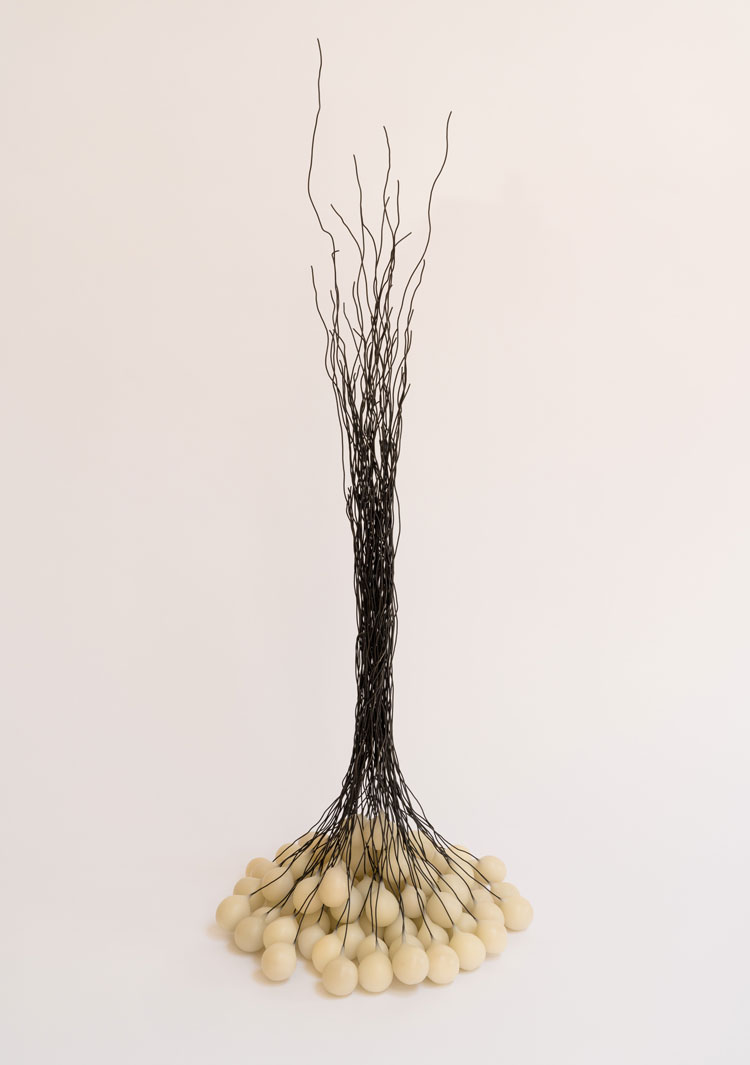
Susie MacMurray. Rapunzel, 2020. Wax and black wire, 76.5 x 28 x 28 cm. Photo: Ben Blackall and Steve Russell Studios.
AMc: Are you happy doing what you are doing now? Did you make the right decision?
SM: Absolutely. People often ask me whether I still play, and they’re surprised when I say that I sold my instrument while I was on my MA course. It was a beautiful instrument, it was amazing, but I had no need to use it, and what I was doing in my art practice was far more satisfying. I think of it as having found a better language to use, a better tool for satisfying my needs than music. Now I can enjoy music by listening to it in the studio. I am making my own stuff now, instead of just being a part of facilitating someone else’s. It is more satisfying.
AMc: I can imagine, yes. Can you tell me a bit about the role of drawing in your practice –using pen and ink, but also less conventional mediums such as hair, rubber tubing and wax? What defines something as a drawing for you?
SM: I guess it’s a question of where the boundaries are between three dimensions and two dimensions. I didn’t draw when I was at art school. It was the era of the YBAs and Sensation, and it was all about the one-liner, conceptual ideas and ready-mades. With the sensibility of a maker, I wasn’t sure there was a place for me in that world. I remember, on the first day of my sculpture course, asking somebody how to tell whether something was any good, and she said: “Oh, we don’t do aesthetics here.” I was deeply unfashionable in the way I was working, and, consequently, I never managed to finish very much in college. I was endlessly pushing stuff around and never resolving it. I had done life drawing on my foundation course, but I didn’t do it at college because it wasn’t required, and it wasn’t considered important.
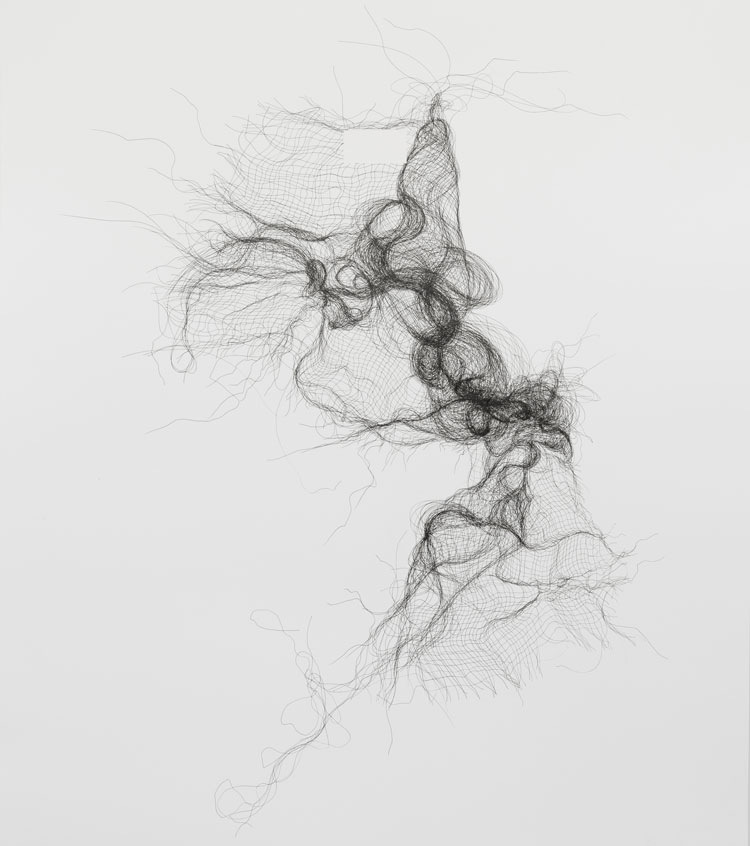
Susie MacMurray. Gauze Bandage Drawing II, 2019. Ink on paper, 152 x 121 cm. Photo: Ben Blackall and Steve Russell Studios.
It was around the time that my husband died, in 2006, that I really started drawing again. It was the only thing I could do. I couldn’t make any work for 18 months after he died because, obviously, I was dealing with the kids and stuff, but, also, I just couldn’t see the point of making art. You wake up each morning, and you can’t believe the world is still turning. Everything goes on as normal, but this huge thing has happened. So I started drawing these tiny little scraps, and it evolved, but it has also become a meditative act, a way of getting lost. When you’re making with materials, you sometimes have to stop and interrogate what you’ve done and try to work out why things are doing what they’re doing. But I find this gets in the way if I bring it in too soon. Drawing is a way of getting my brain into that place, without tripping myself up by asking why all the time and coming up with reasons why not.
I also used drawing quite a lot when I was teaching. When you’re teaching, you’re giving out; you are facilitating other people’s creativity. You spend half a day teaching, and then you end up in the studio, but it can take you half a day to get your brain into your own stuff. You have to make a transition, and I found that, if I had a big piece of paper up on the wall with a work in progress on it, I could just lose myself in that. If I drew on that for half an hour to an hour, I would be where I needed to be. That’s how I’ve always used drawing. I use it when I’m thinking about stuff. I can’t resist drawing bits of materials that are lying around, but I’m not trying to make groundbreaking drawings. It’s very personal, it’s very much for me, it’s just a bonus that they come out as finished things. Then, also, they evolve. Murmur is a sculptural installation, but it’s also very much a drawing in space. Also Promenade (2010), which was an installation at Kedleston Hall in Derbyshire, comprising about 104 miles of gold embroidery thread, spread like a cat’s cradle all around the pillars of the great Robert Adam hall, was like a drawing in space, where the row upon row of fine gold thread became a sort of mirage.
It’s like when people say: “Oh, you’re an artist. What do you paint?” or “Do you call yourself a sculptor?” It’s not very useful. They’re just labels, aren’t they? I’m just an artist. I suppose it comes back to finding the boundaries in between, and the line between soft and hard, resilient and vulnerable, dead and alive, here and not here. A drawing is tangible, but is it on the page, is it in the air, or where is it?
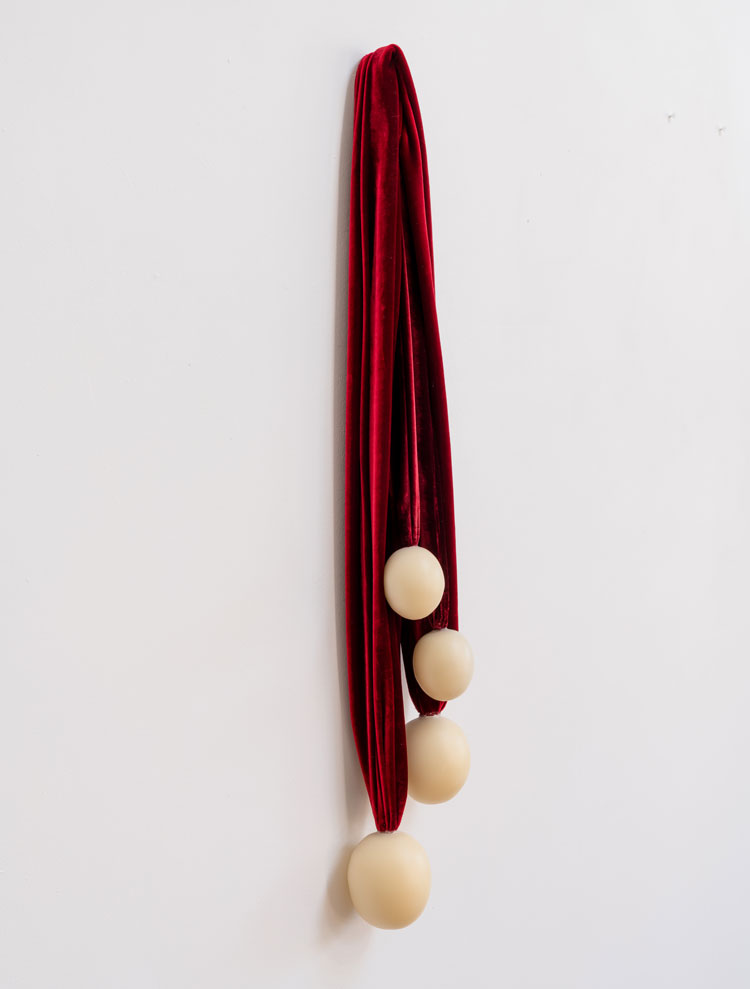
Susie MacMurray. Object, 2020. Silk velvet and wax, 82 x 12 x 8 cm. Photo: Ben Blackall and Steve Russell Studios.
AMc: Your works are very tactile, but presumably people aren’t meant to touch them in a gallery?
SM: No, they’re not, but, again, it’s that cruel dichotomy, whereby I really want them to want to. I want them to feel that they just can’t bear not to, because then you have succeeded – you have engaged them. I want them to feel what I feel, I guess.
AMc: Are there any other feelings or emotions you want your audience to feel? I expect that’s a broad question, the answer to which varies from work to work?
SM: Yes. But you are right – when I say “feel”, I’m not just meaning feel by touch. It’s those two parallel worlds again. They are almost ghosting each other. It’s like the thing in the shadow, isn’t it? Again, with Murmur, the shadows are a big part of it. It’s the physicality and the formality of the object, but it’s also all the theory and the poetry behind it. The ideas that are shadowing are like a ghost, and I think what I am trying to do is make them so enmeshed that it’s almost impossible to talk about them separately.

Susie MacMurray in her studio, July 2020. Photo: Ben Blackall and Steve Russell Studios.
AMc: We mentioned Medusa briefly, but what role do fairytales and mythology play as inspiration in your work more generally?
SM: They are quite fundamental. I always loved fairytales as a child. There is something magic about them. And I don’t mean the Disney variations. I’m a huge fan of people such as Angela Carter and Marina Warner. I guess it’s all about the seen and the unseen. It’s the darkness of them, as well, in the same way as with Greek myths. Medusa is a fairytale, she’s a cautionary tale, she’s the ultimate story about being punished for being raped, and victimhood and revenge. Then you think about the male gaze. That is there in fairytales as well, isn’t it? On the one hand, something like Rapunzel is a fun story, but, underneath, it’s about virginity. The wicked witch is keeping Rapunzel to herself, she’s protecting this child from the big wide world, and she’s protecting her virginity. They all have a subtext, don’t they? All the iconic women in them, from the wicked stepmothers to the princesses, they are all cautionary tales. They warn women about a world they’ve got to negotiate with such caution, and they tell them about their power and their vulnerability at the same time.
When you are sitting around with a group of art students, making artwork, you are doing the same. You talk about the world. It’s a bit like walking and talking. Stuff comes out that wouldn’t come out if you sat face to face and had a chat in a tutorial. And if you’re coming back and doing the same thing every day, day after day, you can carry on the conversations, and thoughts can seep in and be considered and brought back into the making. They become inextricably mixed together, it’s like magic. That’s what magic is: it’s mystery and wonder. I can interrogate art and talk about theory and where everything comes from, but there’s also something indescribable about it, and I often say: “If I can explain to you exactly what a piece of work I’ve made is all about, then there’s absolutely no point in having made it.” It’s a question, not an answer.
AMc: I always feel I’m doing myself out of a job when I have this kind of conversation, but I agree. For me, a successful artwork should speak for itself. Yes, you can give context. Yes, you can have a wider discussion around it. But if it fails to say anything without all of that, then it has failed as a work of art.
SM: Yes, you put the label on the wall, but no amount of writing on that label can make something do something if it’s not actually doing anything. As an artist, people want you to explain your work. And I want to explain my work, but then I also don’t want to explain my work.
AMc: How, then, do you go about giving titles to your work? Are they an attempt not to explain, but perhaps to offer a clue as to what the work is about?
SM: Yes. I love words. Maybe it’s a product of having done my art training when I did. There was a kind of intellectual – I hesitate to say snobbery – but barrier. It was almost as if, if the work was too understandable, it wasn’t very good. It’s a kind of elitism, I suppose. I’m not a populist in any way, but I think a title is really important. It’s like another material in the work. What I want is to find a way of giving the viewer a way in without shutting it down. It’s so subtle. If you call something one thing, it brings in all these connotations.
It’s the same way that materials have connotations. I want a title that focuses the work, but doesn’t shut it down. I also think words are beautiful, so it’s another sensual thing. I love the word “perish”, for example. We all perish, don’t we? But then I love the connection it has with when I was starting out and making a lot of work with latex and balloons. Latex perishes, and I love the way that the word works in both senses, fitting everything. I made a piece called Glad Rags, which was a great big ball gown made out of pink balloons. It was made in reference to a friend’s daughter, who was struggling with anorexia, and, because it was made of latex, which is like the sap of a tree, it had a fantastic connection to skin and blood. I found it a very poetic thing, but also really earthy. Words are very evocative, and so it’s a bit like trying to find the right materials to put together. I’m not trying to say. I’m trying to ask, I’m trying to bring you in. I’m trying to bring you into my debates and dilemmas and fascination with the way things hover. And I think a title is absolutely key in that, and it’s so hard to get it right. Sometimes they come straight away, at the moment of the idea. I’m making a piece at the moment that’s going to be another garment sculpture made from sliced deer antlers, and I knew, from the moment of the initial idea, that it was going to be called Stalker. It’s going to be a female figure – Diana. Again, there’s that hook: are you the hunter or the hunted? For other pieces, however, I have struggled right up to the moment of the exhibition opening, trying to find titles for them.
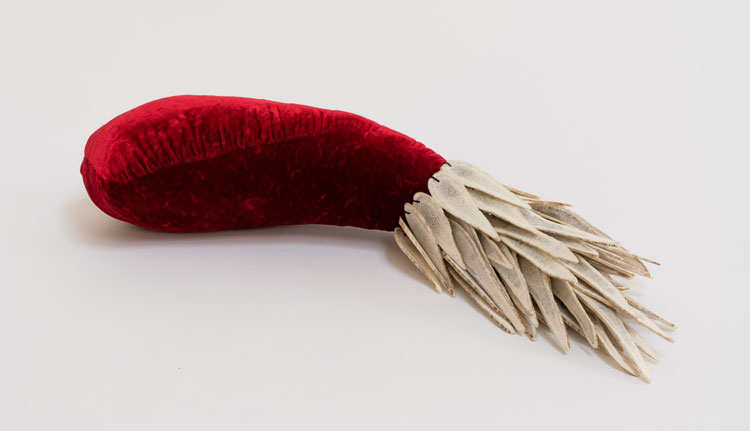
Susie MacMurray. Foundling, 2020. Sliced deer antlers, silk velvet and stuffing, 10 x 44 x 10 cm. Photo: Ben Blackall and Steve Russell Studios.
AMc: Aside from the title, how, generally, does a work evolve? Do you envisage what it is going to look like from the outset?
SM: Not usually. Sometimes, such as with these garment pieces, I might, but they always evolve. And certainly, with a sculpture, I don’t. It’s a journey. I think that’s why I don’t use drawing in that way. I can’t remember ever having drawn something and then trying to make it. It is to do with the tensions between different kinds of materials – the work suggests itself as it goes along. It’s a very evolutionary process. It’s not the easiest way to work. Sometimes I think it would be so nice just to think: “Oh, I’m going to make this,” and then to go and make it. But it’s never easy. I’m not a painter who just has one process. I start from scratch every time, finding a new technique.
AMc: You tend to make everything by hand as well, except for your first foray into working with bronze for this exhibition.
SM: I never thought I would do that, never ever. It just seems so alien to my whole process. But then I was lucky enough to be working with Pangolin London and to have that affiliation with the foundry. When Polly asked me, this time last year, if I would like to go down to the foundry, see what they do, and spend some time there, I knew I had to give it a go. I went into the wax department and sat and made stuff with them. It was absolutely magical. I fully admit I was prejudiced about bronze – and all the connotations it carries – but it was amazing. I was anxious about the fact that I was letting go of some of my process, because usually my hands are on it all the way through to the very end, and to let someone else cast it and patinate it was weird. But I love the alchemy of the transformation. It’s quite fairytale again, in a way. And because the original wax is destroyed in the process, you can never make another copy, it’s like a monoprint, and that fits with my practice. One of the things I did was to dip velvet in wax, and that created the Shard pieces. I really loved the way the wax drained down the velvet. And when we tried casting them, the cast came out with this fossilisation of the material. You could clearly see what it was, which went against my idea of bronze as just being statues and polished objects that don’t relate to the world.
AMc: You’ve certainly managed to keep the sense of ephemerality, rather than creating a solid lump of metal.
SM: Yes. Like I say, in that way it was quite fairytale, quite Angela Carter … The idea of things being transformed and metamorphosing, spinning straw into gold, or being turned to stone and shards of ice. So, yes, it was a great experience. It pushed me out of my comfort zone, but it was great.
AMc: Do you think you’ll work with bronze again?
SM: If I can afford to, yes. That’s obviously the other thing. When I was in art school, a tutor gave me a good piece of advice. She said: “It is a good idea, if it suits your practice, to try and work in a way that you can go on working in when you leave the institution, and not to be dependent on workshops and foundries.” And that is what I have done. I have stayed very self-sufficient.
• Susie MacMurray: Murmur is at Pangolin London until 31 January 2021. Pangolin is shut due to the Covid lockdown. For more information, visit the gallery site here.
Click on the pictures below to enlarge